From bikepacking to gravel racing, our expert testers bring together the very best gravel bikes
If you’re looking for an objective assessment of the best gravel bikes on sale in 2024 then you’ve come to the right place. All of the bikes in this article have been ridden and rated by BikeRadar’s expert testers.
Gravel and all-road are terms used for this rapidly growing segment of the drop-bar bike market. These bikes have generous tyre clearances and gravel-specific geometry that is typically more stable and forgiving than traditional road bike geometry.
Modern gravel bikes were born out of the American Midwest, where gravel racing took hold a decade ago and has gained popularity steadily.
In the early days, riders tackled these endurance events on cyclocross bikes. Today, there are numerous purpose-built machines, from gravel race bikes and versatile all-road bikes that rival the best road bikes, to progressive gravel bikes that resemble drop-bar mountain bikes.
Our team of testers have been involved in the world of gravel bikes since its inception. Our senior tech editor Warren Rossiter first tested a thoroughbred gravel bike at the beginning of the 2010s and since then he reckons he’s tested close to 200 gravel bikes.
Many of our testers have also come to gravel via road riding or mountain biking. They bring a unique mix of insight and expertise, analysing how these bikes compare to the best road or best mountain bikes.
The selection of gravel bikes in this list represents the very best gravel bikes we’ve tested, across frame materials, riding styles and price points. This means there should be something for everyone, from those looking for a cheap entry into off-road riding to those looking to take on the Silk Road Mountain Race or Unbound.
The best gravel bike frames come in the same variety of frame materials as other bike types, with carbon, aluminium, titanium and steel options commonly available.
We have split our list of top-performing gravel bikes into each different frame material. You can skip to each section depending on what you’re looking for in a gravel bike:
- Carbon gravel bikes offer low weights and balance stiffness and compliance
- Aluminium gravel bikes are often the most affordable option
- Titanium gravel bikes are incredibly desirable and often considered ‘forever bikes’
- Steel gravel bikes have a classic feel and tend to be favoured by bikepackers
You can also skip to our buyer’s guide to gravel bikes, which explains everything you need to know about these practical, versatile and fun bikes.
Best gravel bikes in 2024
Best carbon gravel bikes
Carbon fibre gravel bikes are lightweight, stiff and are designed to absorb vibrations effectively.
Carbon fibre’s pliancy will do a lot of work to minimise any chatter from the surface beneath while still letting you put a lot of power through the cranks.
Many gravel race bikes are made from carbon, but there are plenty of carbon gravel bikes tailored to bikepacking and more technical riding.
Below is a selection of carbon gravel bikes we have tested that encompasses most of the above. Head to our full buyer’s guide to the best carbon gravel bikes for a complete rundown of every model we have tested.
Canyon Grail CFR Di2
- £6,699 / €6,999 / AU$10,599 as tested
- Pros: Calm, confident and stable handling; well-designed frame storage; comfortable
- Cons: Tyres are fitting for the genre but slightly fragile; we’d have preferred regular mudguard mounts
Canyon revamped its Grail gravel race bike in 2023, with the new bike incorporating nifty features such as down tube storage and a new Double Drop handlebar that replaces the controversial Hover bar of old.
Some may wish for a more voluminous tyre clearance, with the Grail rated for 45mm rubber.
Deputy editor Jack Luke found it to be one of the best-handling bikes he’s ever ridden and was very impressed by its confident, sure-footed handling at high speed without being dull on technical terrain.
It’s a comfortable ride, too, thanks to the well-considered geometry. There’s plenty of scope to adapt the bike to your riding, thanks to the novel Gear Groove feature on the handlebar and provision for Canyon’s own mudguard. You can even add the brand’s new Fork Sleeve for triple cargo mounts on the fork for bikepacking.
Be aware the Schwalbe G-One RS tyres are a race-oriented option though and are therefore a bit delicate for especially rocky riding.
Canyon Grizl CF SL 8 1by

- £2,949 / $2,849 / €2,699 / AU$4,249 as tested
- Pros: Versatile carbon frameset; great spec; well thought out geometry
- Cons: Gearing might not be low enough for some; Canyon-specific mudguard mounts
The Canyon Grizl is a burlier version of the Canyon Grail, which is also one of the best gravel bikes. The Grizl has clearance for 50mm tyres, mounts for fenders and bags, and long geometry – all working together to make it an ultra-versatile bike.
The bike has a good value-for-money spec, with a Shimano GRX groupset, DT Swiss wheels, a Canyon VCLS leaf-spring seatpost and a Fizik Terra Argo saddle.
The Grizl is happy on tarmac, but really shines off-road, especially on dirt trails and gravel singletrack.
The 1x drivetrain might not be the desired choice for all, but there are 2x Grizls in Canyon’s range.
One drawback with this bike is the mudguard mounts are specific to Canyon.
Giant Revolt Advanced Pro 0
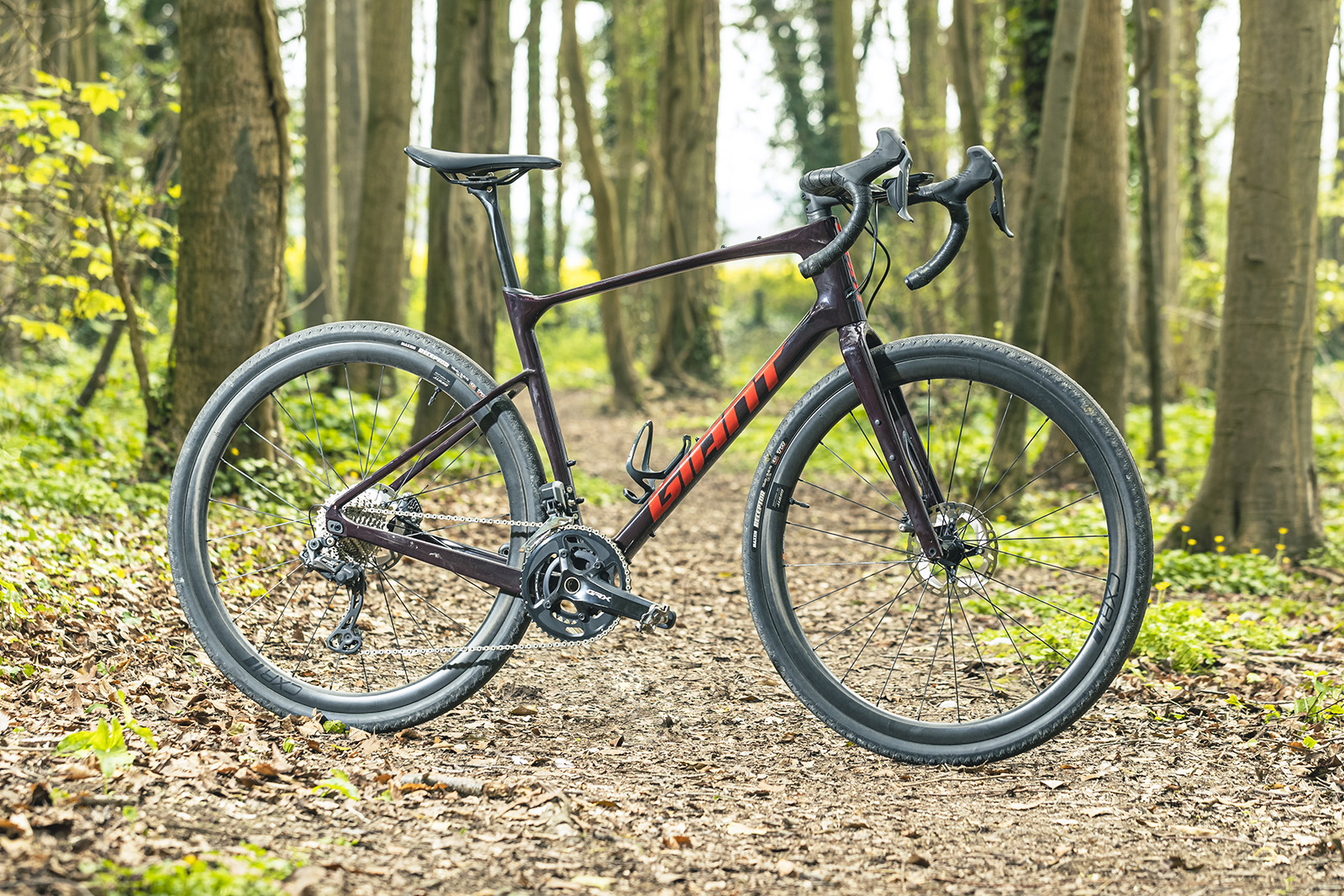
- £4,999 / $6,400 / €5,599 / AU$6,699 as tested
- Pros: Thrilling and plush ride; great groupset; fast wheels
- Cons: Tyres aren’t suited to wet or muddy terrain
The Giant Revolt Advanced Pro 0 is our Bike of the Year for 2022, the first time a gravel bike has won overall. Equipped with Shimano’s GRX Di2 2x groupset, the Revolt’s shifting and braking is pretty much flawless.
The build weight of 8.3kg doesn’t suggest sprightliness, but Giant’s lightweight CRX wheels and sharper geometry make the Revolt spry on- and off-road.
The new fork permits the Revolt to run tyres up to 53mm wide.
The Revolt also has plenty of mounts and bosses to carry luggage on bikepacking trips.
The Giant Revolt X Advanced Pro 1 is similar to the Advanced Pro 0, but it has a gravel suspension fork for more technical riding.
Liv Devote Advanced Pro

- £4,699 / $5,500 / €5,000 / AU$7,299 as tested
- Pros: Women’s-specific geometry; dropper seatpost compatibility
- Cons: Tyres are sketchy in the wet
The Liv Devote Advanced Pro is the brand’s first gravel bike and one of the best women’s gravel bikes.
As with the rest of the Liv range, the frame’s geometry/sizing and carbon layup have been chosen specifically with female riders in mind.
The shock-absorbing seatpost is very effective at reducing trail buzz. The bike will also accept a dropper post should you want to maximise the bike’s handling on descents.
It’s a bike that is supremely comfortable over long distances and has mounts for mudguards, luggage, bottles and accessories, so it’s ready for as much adventure as you can take on.
Trek Checkpoint SL6 eTap
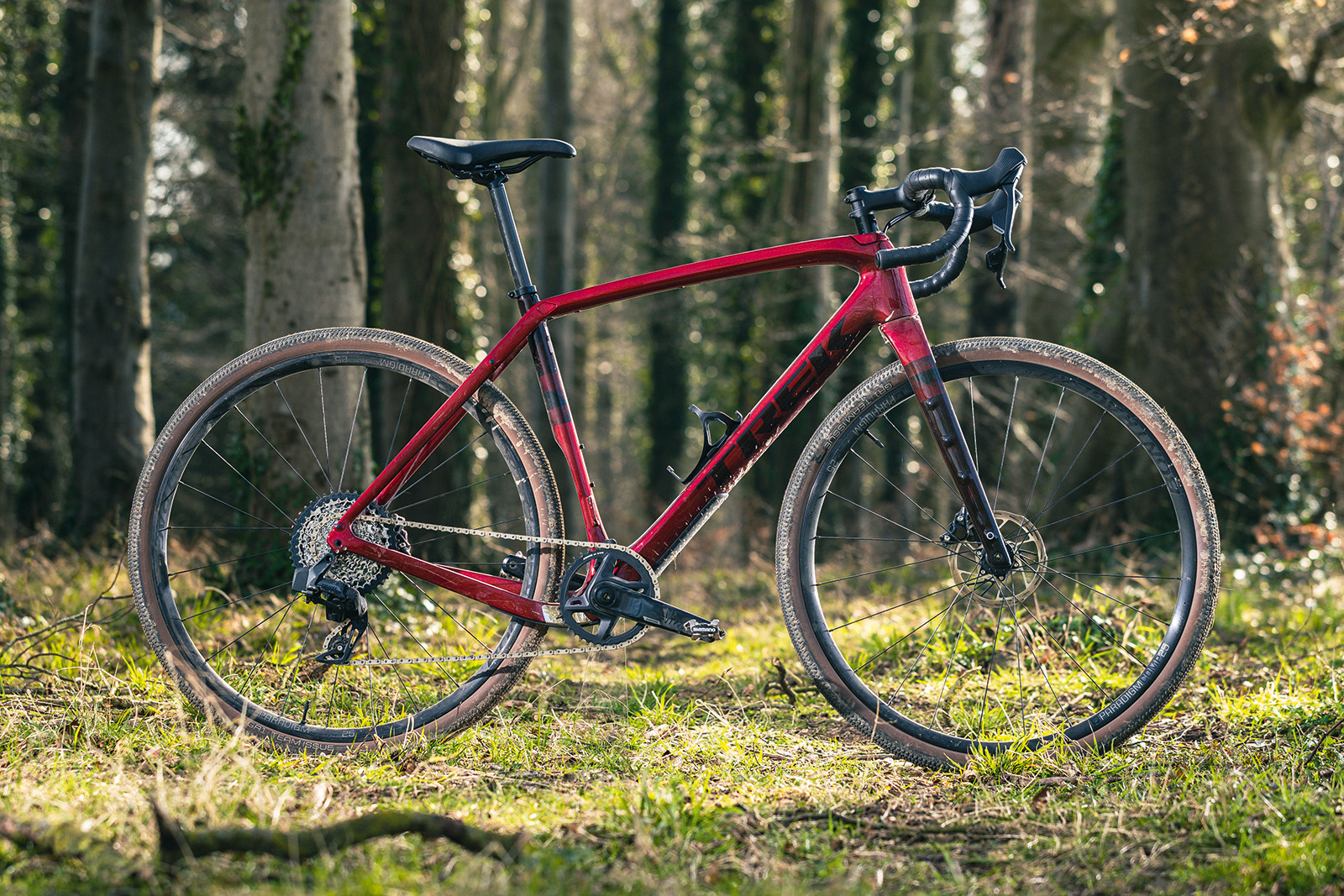
- £3,850 / $4,300 / €4,300 / AU$5,500 as tested
- Pros: Comfy and fairly fast; mounting options; excellent handlebars
- Cons: Can be rattly
The Trek Checkpoint SL6 is a multifaceted gravel bike adept pretty much anywhere off-road. While no featherweight, it’s not sluggish on tarmac or faster fire roads.
Trek’s IsoSpeed decoupler, which allows the frame to flex a touch, absorbs the worst of bumps. The Checkpoint’s maximum tyre clearance of 700cx45mm or 650×2.1in allows you to run wide gravel tyres for added comfort and traction.
SRAM’s Rival AXS XPLR 1x groupset forms part of a fair-value spec. Stacks of fittings make the Checkpoint a practical steed for bikepacking.
The bike has one of the best gravel handlebars with long drops and a generous reach.
Lauf Seigla Weekend Warrior
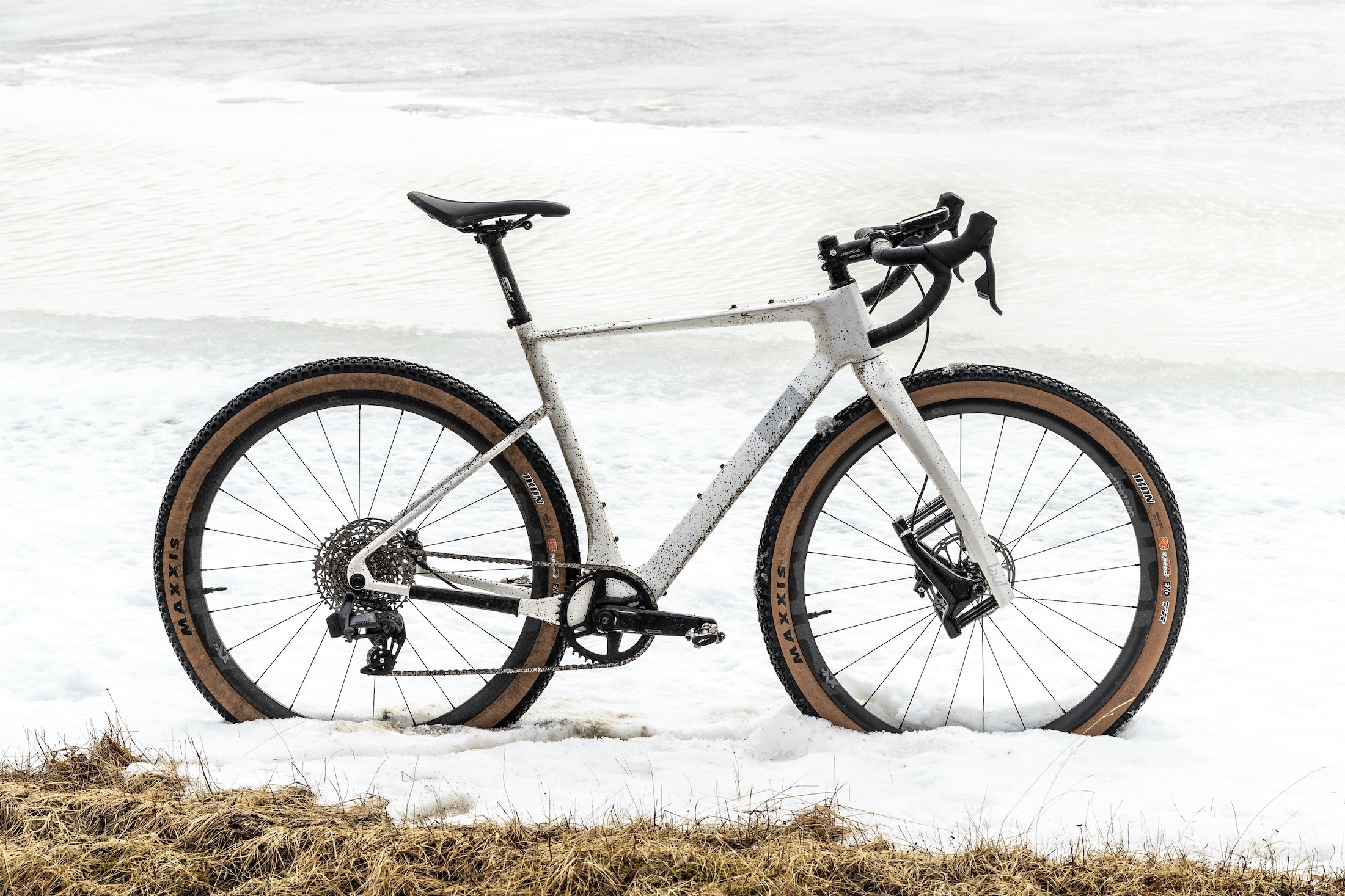
- £3,890 as tested
- Pros: Inspired geometry; grit fork smooths surfaces; wide tyre clearance up to 29 x 2.25 in
- Cons: Wide bottom bracket limits crank choice; fork chassis can twist
Lauf’s Seigla has taken all of the best aspects from its True Grit gravel race bike and improved it, with increased tyre clearance and frame compliance.
The third-generation Grit leaf-sprung fork offers class-leading damping. Although you can feel a little bob from the fork, it’s a fairly efficient climber. Heading downhill, the Seigla is composed and takes the sting out of the worst bumps.
There are some quirks in the frame’s design, which although aren’t a negative, are certainly something to consider for your style of riding. The Seigla isn’t compatible with front derailleurs and it uses a wider BSA73 bottom bracket shell, limiting crankset options.
Orbea Terra M21e Team 1X

- £5,358 / $5,874 / €5,364 as tested
- Pros: Compliant and comfortable; quick handling; fast
- Cons: Wheels warrant an upgrade
The Orbea Terra M21e Team 1X is one of the most appealing gravel bikes on the market, offering all-round capability, speed, comfort, confident handling and last but not least, fun.
The lightweight frame doesn’t drag on long climbs and would be a good choice for gravel racing. But it also smooths out rough terrain and our tester felt it could be a great companion on technical sections. To boot, there are plenty of mounts for bikepackers.
The Terra is held back by its alloy wheels. A lighter, faster set of gravel wheels would complete this carbon gravel bike.
Vitus Venon EVO-GR Rival AXS 1x

- £3,500 / $4,099 / €3,900 / AU$6,300 as tested
- Pros: Versatile across road and gravel; forgiving ride; well-considered geometry
- Cons: Not ideal for technical terrain
Vitus’ Venon EVO-GR Rival AXS 1x is the gravel-oriented flavour of the Venon Evo, which took home our coveted Bike of the Year gong in 2023.
The bike greatly impressed in its gravel trim and the sharpness of the frame and fork hasn’t been diluted by the off-road rubber. The handling is stable and easy to control, and the Michelin Power Gravel tyres offer plenty of grip in the dry, with only mud tripping them up.
While it isn’t a match for more technical terrain thanks to its predominantly endurance road bike-inspired geometry, it’s certainly in keeping with other gravel race-oriented bikes such as the BMC Kaius or Specialized Crux.
Cannondale Topstone Carbon Rival AXS
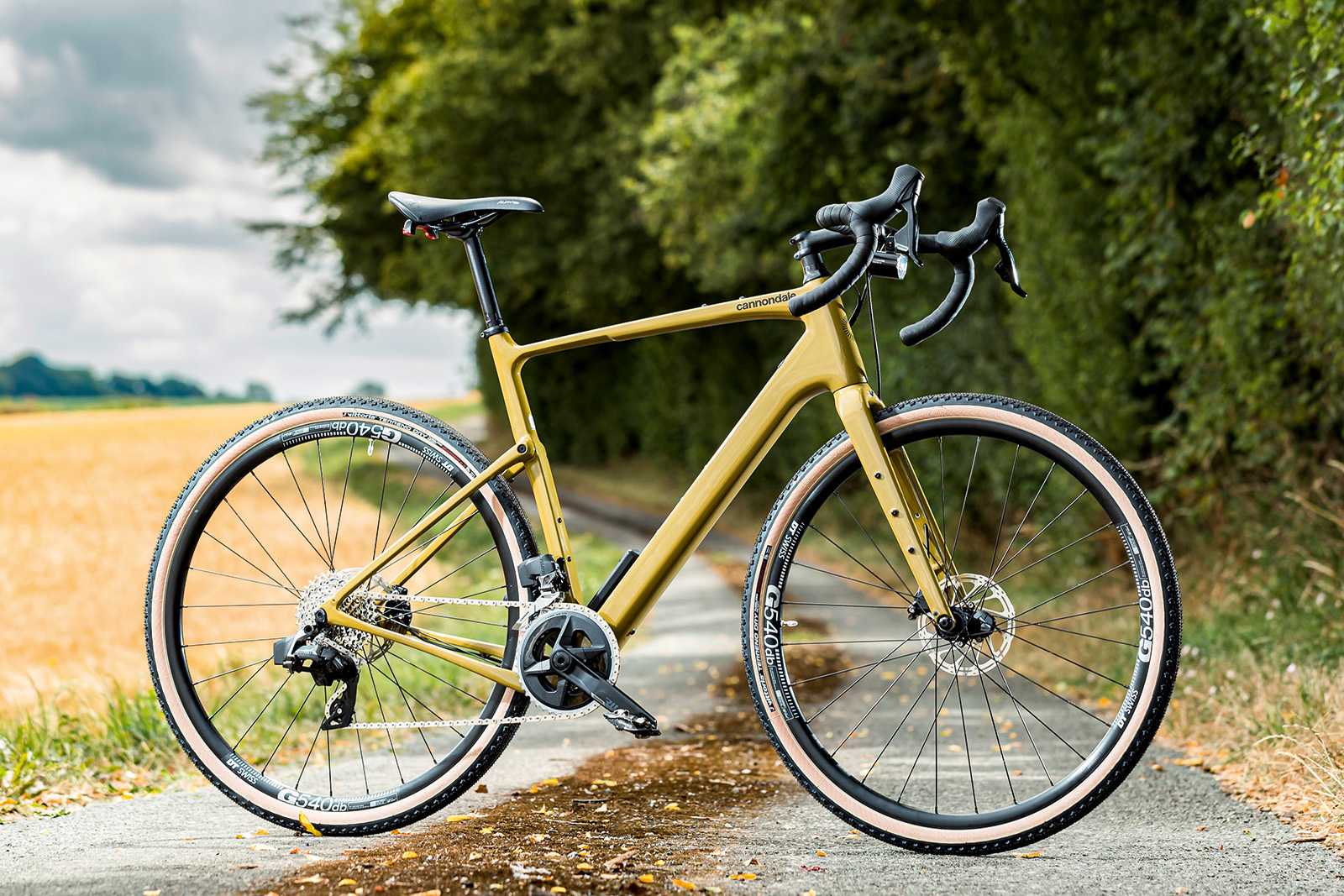
- £4,850 as tested
- Pros: Inspiring and fun handling; Cannondale’s Kingpin suspension; integrated lights
- Cons: Lights not powerful for off-road riding
The Cannondale Topstone is a mainstay of the gravel bike world, and this latest iteration offers an ideal blend of fun and versatility.
Integrated suspension and tweaked geometry make the bike capable and comfortable on rough terrain, but it can still cruise along like an endurance road bike on tarmac.
While the choice of a 2x SRAM Rival AXS drivetrain might seem at odds with the trend for 1x drivetrains on gravel bikes, there’s no getting away from how well this electronic groupset performs.
With an eye on practicality, Cannondale has added integrated lights to the Topstone. However, these aren’t really powerful enough for off-road riding in the dead of night.
ENVE MOG (Shimano GRX Di2 build)
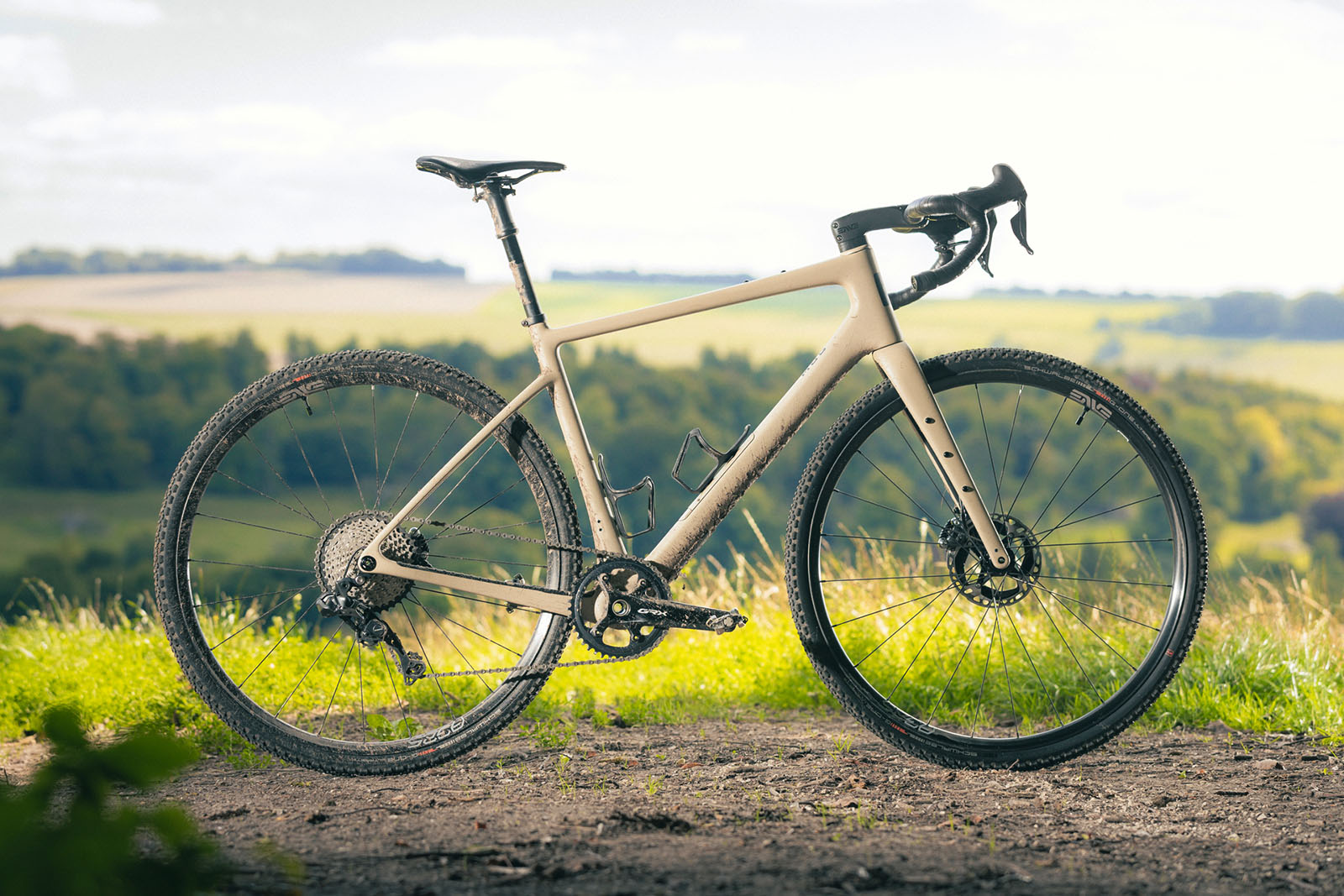
- £10,500 as tested / £5,500 / $5,500 for frame module
- Pros: Nimble and capable handling; well-balanced
- Cons: Expensive and no off-the-peg builds
The ENVE MOG is positioned between a gravel race bike and more adventure-oriented options. Like its Custom Road and Melee road siblings, the MOG is sold as a frame module, so you’ll need to add a gravel groupset, wheels and tyres. That means there aren’t any off-the-shelf builds.
The carbon fibre frame has clearance for 50mm gravel bike tyres and it features the ‘Cargo Bay’, ENVE’s term for its down tube storage, with 600ml capacity.
We were very impressed by its off-road manners – it’s a quick bike but feels composed enough when snaking through gnarlier terrain. It’s a much more rounded bike than expected, more akin to the Giant Revolt X or Cannondale Topstone than racier rigs.
This example build pairs a Shimano GRX Di2 groupset with ENVE AG25 wheelset and finishing kit, including its G-Series inverted dropper post.
Specialized Diverge STR Expert
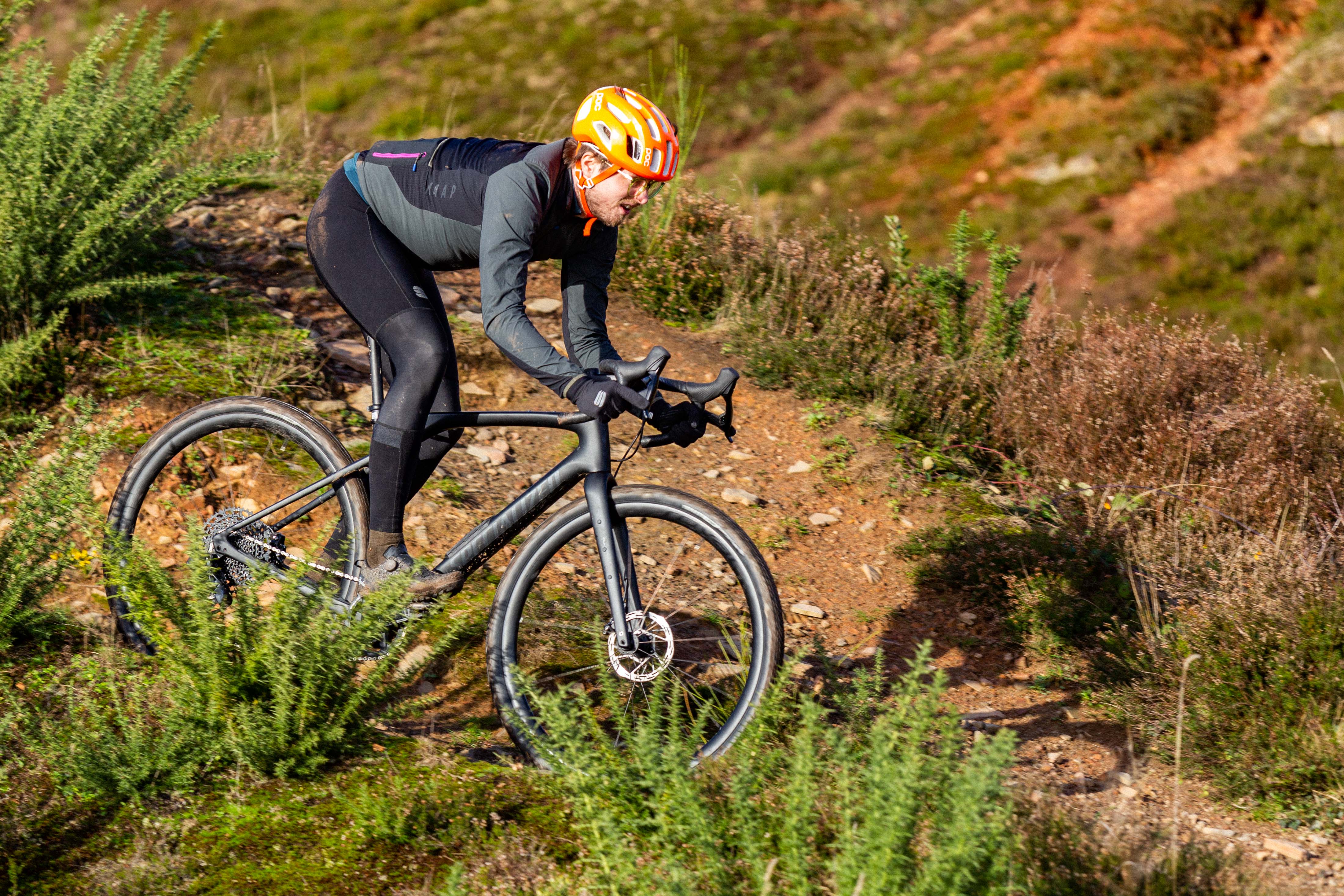
- £7,500 / $7,500 / €7,550 as tested
- Pros: Plush riding in the saddle; all-round capability
- Cons: Low spec for the high price
The Specialized Diverge STR Expert brought in Future Shock Rear suspension, which suspends the rider’s behind and reduces discomfort off-road. The setup process is complicated, but the design effectively dampens vibrations, enabling you to remain in the saddle more.
Another positive is that the Diverge STR Expert’s geometry is suitable for a broad spectrum of gravel riding, from bridleway bashing to pacy gravel racing.
The middle-of-the-range SRAM Rival and GX Eagle components are discordant on a £7,500/$7,500 bike. The frame’s complexity does offer some mitigation for these cost-cutting choices.
The Specialized Diverge STR Expert will please fans of fancy tech and out-there looks, but the Specialized Diverge Comp Carbon might be a better – more affordable choice – for some.
Best aluminium gravel bikes
Aluminium alloy frames are light, robust and have a relatively low manufacturing cost. This makes aluminium gravel bikes a great choice if you’re looking to dip your toe into the world of gravel because they deliver big performance for their relatively low price.
Many of the best gravel bikes have aluminium frames and can compete with carbon or titanium bikes, so it’s not to be overlooked even for more performance-orientated people.
Below is a selection of the best alloy gravel bikes we have tested, with a particular focus on budget gravel bikes. Our complete buyer’s guide to the best aluminium gravel bikes covers a broader range of price points.
Boardman ADV 8.9
- Buy now from Halfords

- £1,150 as tested
- Pros: Good spec for the money; energetic ride; proper all-rounder
- Cons: Bar can transmit vibrations at higher pressures
In 2022, the Boardman ADV 8.9 was our Budget Bike of the Year for the second year rolling, having increased only slightly in price since 2021.
The ADV 8.9 has the cheapest Shimano GRX RX400 groupset, which shifts and stops well. The 48/32T chainrings and 10-speed 11-36T cassette is highly versatile.
Much of the ADV 8.9’s kit is from Boardman, including the fast-rolling wheels shod with Schwalbe G-One Allround tyres. Converting these to tubeless would enhance off-road performance.
The handlebar tape could also be upgraded to dull vibrations from harsh surfaces transferring through the bars – especially at higher tyre pressures.
- Read our full Boardman ADV 8.9 review
- Buy now from Halfords
Canyon Grail 6

- £1,649 / $1,699 / €1,499 / AU$2,349 as tested
- Pros: Top components for the cash; amazing performance for the money
- Cons: 10-speed; no rack mounts, like the older version
The Canyon Grail 6 is a versatile aluminium gravel bike that’s a direct replacement for the hugely successful Grail AL. Despite being the cheapest aluminium frame Canyon Grail build, it’s still a very well-equipped bike.
The Shimano GRX 2×10 transmission and matching hydraulic disc brakes can be thought of as Tiagra equivalents.
Trusty DT Swiss C 1850 db alloy wheels are another spec highlight, particularly when shod in 40mm Schwalbe G-One Bite tubeless-ready tyres.
The Grail is a confidence-inspiring bike to ride, and one that beats its predecessor off-road thanks to gravel-specific gearing. It’s a comfortable enough bike as is, but run the tyres tubeless and you can further take the edge off.
The gravel bike is also available in a women’s-specific version, the Canyon Grail 6 WMN.
Focus Atlas 6.8
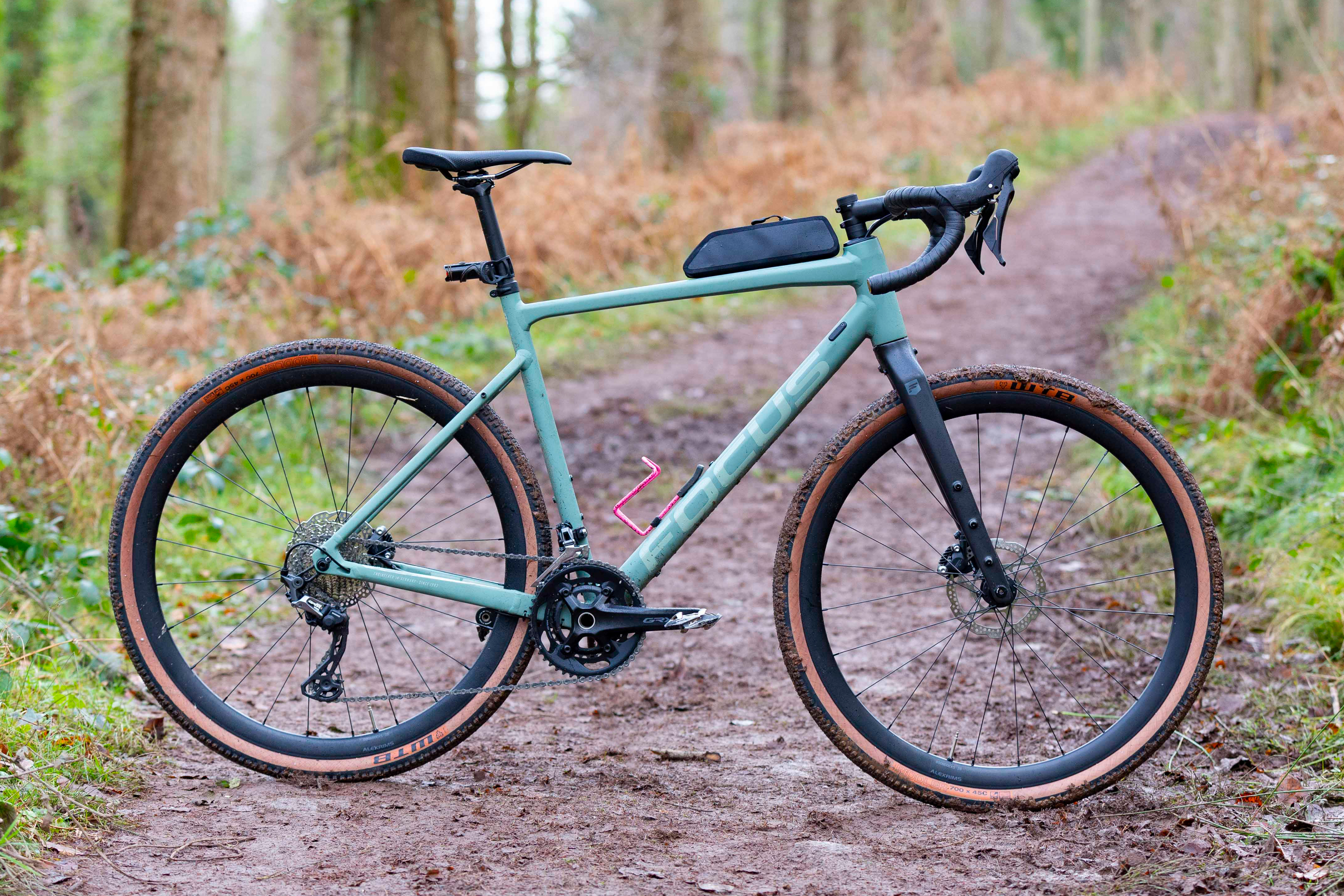
- £1,899 / €1,999 / AU$3,099 as tested
- Pros: Touring and bikepacking-friendly; progressive geometry; excellent-value package
- Cons: Boost spacing limits wheel choice; top tube bag rattles
The Focus Atlas 6.8 is an entertaining and very capable bike straight out of the box. It’s a particularly talented off-roader thanks to progressive geometry that keeps things notably calm even when the going gets steep or rough.
It’s great to see a mix of Shimano’s excellent GRX RX600 and RX800 groupset components at this price.
The stock wheels are tough and form a great foundation for WTB’s 45mm wide Riddler tyres, though the Boost axle spacing could make potential upgrades more complicated.
Focus has included plenty of mounts and provisions for luggage and accessories, making the Atlas ideal for bikepackers.
Cannondale Topstone Alloy 2
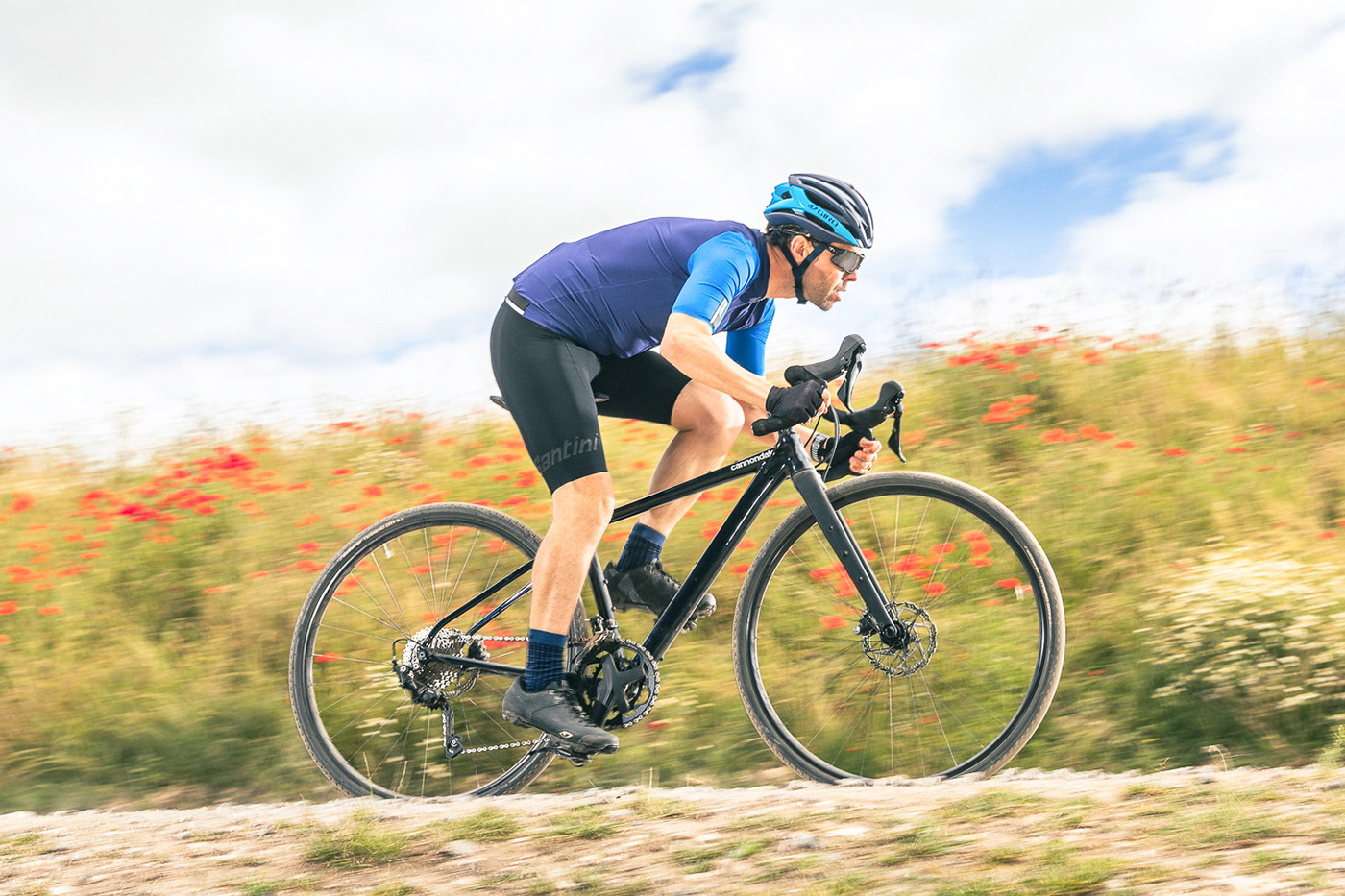
- £1,800 / $1,925 / €2,199 / AU$3,199 as tested
- Pros: Accessory mounts boost versatility; great tyres for light gravel and road riding
- Cons: 10-speed groupset; relatively narrow tyres
The Cannondale Topstone Alloy gravel bike was updated in mid-2022 with dropped seatstays, additional accessory mounts and new builds.
We tested the mid-range Cannondale Topstone Alloy 2, which is built around a Shimano GRX 400 groupset.
With loads of accessory-fitting options and ample tyre clearance (45mm), this is a bike that could quite reasonably be turned to nearly all riding duties, including doubling as a winter road bike or commuter bike.
However, the stock tyres are on the narrow side if you want to explore more technical gravel/off-road trails, though that’s nothing an upgrade to wider rubber can’t sort.
Best titanium gravel bikes
Titanium has become a popular material amongst the best gravel bikes thanks to its inherent properties.
The metal is more resistant to fatigue than aluminium alloy, roughly half the weight of steel and more flexible than carbon fibre, making it a good choice for riders who value performance but want a sleek-looking forever bike that can stand up to the demands of riding off-road.
You can also check out our full list of the best titanium gravel bikes for a complete overview.
J Laverack GRiT

- £6,325 as tested
- Pros: Build quality; handling; performance; comfort
- Cons: Squeaking brakes; need to up-spec the bike to get the most from it
Our tester found the J Laverack GRiT to be the closest to a “forever bike” thanks to its dependable, comfortable, quick and fun ride – not forgetting its high build quality.
It might not be a surprise that a bike for life comes with a pretty high price tag. The GRiT we tested cost more than £6,000 with Hope brakes, carbon rims and a Shimano GRX groupset.
But in the scheme of things, J Laverack provides custom-specced builds that come in lower than some brands’ second-tier bikes.
You may not want to customise a build to get the most from a bike. However, along with the Hope brakes squeaking, that’s the only real drawback we can find with this bike.
Mason Bokeh Ti GRX Di2

- £6,195 as tested
- Pros: Sublime frame with lovely ride quality and great kit
- Cons: Chunky tyres make it a little pedestrian on the road
We’ve long been big fans of Mason’s aluminium gravel bike, the Bokeh, so we were pleased to see much of what we loved about that bike has translated across to the titanium version.
There are smart details galore, from the numerous mounts for bottles, racks and mudguards, to the MultiPort cabling system that ensures compatibility with all kinds of drivetrains.
As you’d expect, the ride quality is also excellent. The frameset, custom Mason/Hunt wheels and chunky tyres make for a wonderfully composed ride off-road.
The only issue is that it comes at a relatively high price, but if you’re willing to part with this much cash, you’re unlikely to be disappointed.
Reilly Gradient
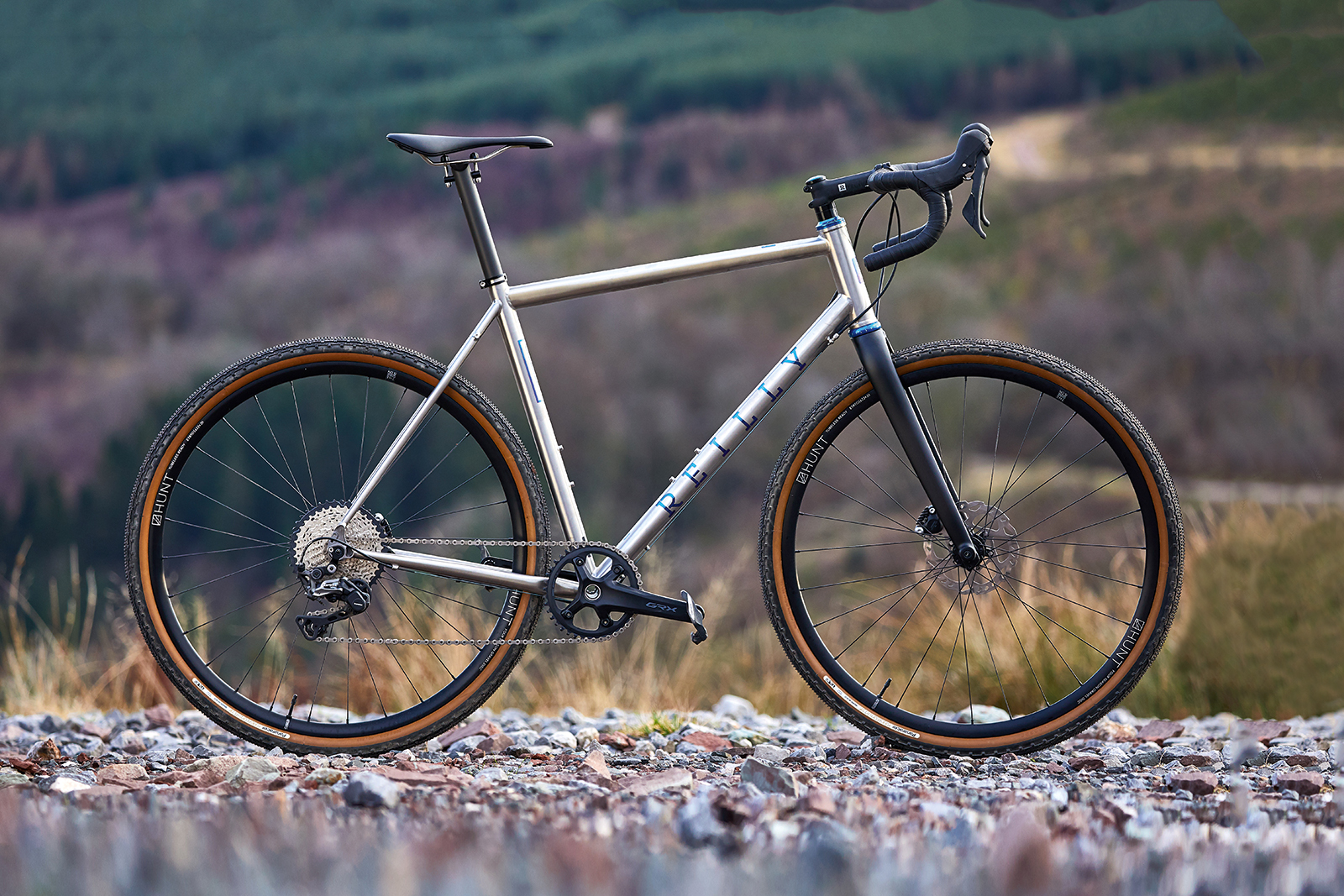
- £3,249 as tested
- Pros: Well priced for titanium; clever build kit; comfortable and quick
- Cons: Gears needed adjusting after a few days’ riding
The titanium Reilly Gradient frame is not only a thing of beauty, the ride it delivers also manages to hit the sweet spot between comfort and speed.
The well-considered build puts Hunt’s 1,629g 4Season tubeless-ready alloy gravel wheelset at either axle and it’s driven and stopped by Shimano’s excellent gravel-specific GRX groupset.
It all adds up to a ride that feels road-bike precise on tarmac, yet controllable off it. It’s reasonably priced too, particularly for a titanium bike that’s built in the UK.
Moots Routt 45
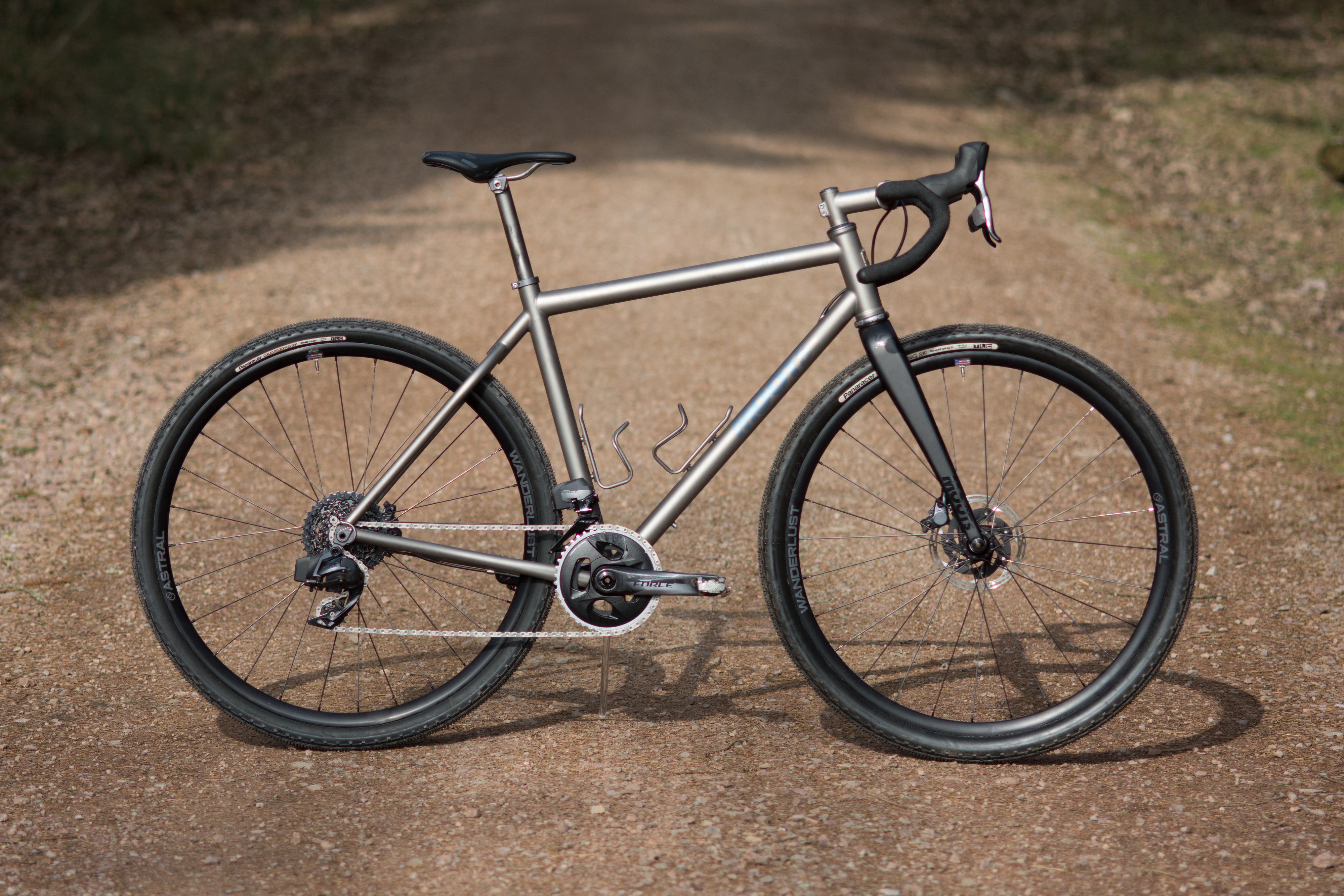
- £5,600 / $4,999 (frameset only) as tested
- Pros: Super-smooth ride and stunning finish; 700x50mm tyre clearance
- Cons: That price tag
You can tell the Moots Routt 45 is a cut above mass-market titanium frames straight away.
Handmade in America, the welds are super-neat and the finish looks expensive.
Despite being available as complete builds in the USA, in the UK Moots bikes are currently only available as framesets.
Riding the Routt 45 with SRAM Force eTap AXS, a Chris King headset and an ENVE bar, the Routt 45 proved super-smooth to ride on- and off-road with plenty of stiffness when pedalling.
The price puts it in the territory of the most expensive bikes. But a bike like this will often be heart over head, and with the right finishing kit, it won’t leave you disappointed.
Best steel gravel bikes
Steel is strong and relatively flexible metal. This means the best steel gravel bikes will do a lot of work to absorb the vibrations of the surface beneath you.
Paired with wide gravel tyres, it creates a smooth and comfortable ride. It isn’t the lightest material, but when comfort and durability are the most important factors you can’t go far wrong with steel.
Marin Nicasio

- £845 / $899 / €899 as tested
- Pros: Amazing value; ideal for bikepacking
- Cons: Hard to fault at this price
The Marin Nicasio proves that simplicity is key when you’re working on a budget. It would be easy to discard this bike based on its simple steel frame and fork, and relatively high weight, but that would be a real mistake.
Yes, you’ll feel the weight on steeper climbs, but the cleverly chosen spec and excellent geometry make this bike a treat as soon as the going gets rough.
This is one of the most fun bikes to ride of its kind and yet it retails for less than the frameset of many of the best gravel bikes.
Cinelli Nemo Gravel Disc Ekar Mendini

- £5,149 / $6,936 / €6,000 as tested
- Pros: Fantastic ride on road and lighter gravel
- Cons: struggles on more technical terrain; relatively narrow tyre clearance; low spec wheels
Cinelli’s steel gravel bike combines great looks and ride quality, thanks to its top-spec Columbus Spirit HSS triple-butted tubing.
It’s built to be fast with angles close to those of a road bike, but still enough fork trail for off-road terrain.
The Campagnolo Ekar groupset works great – both its shifting and braking – but the Fulcrum wheels feel sub-par on a bike at this price.
Tyre clearance is stated at 40mm, but that doesn’t leave room for mud and we got some clogging in typical UK spring conditions.
All that adds up to a gravel bike well-suited to fast trails, but not best-suited to more demanding terrain.
Ribble CGR 725 Steel
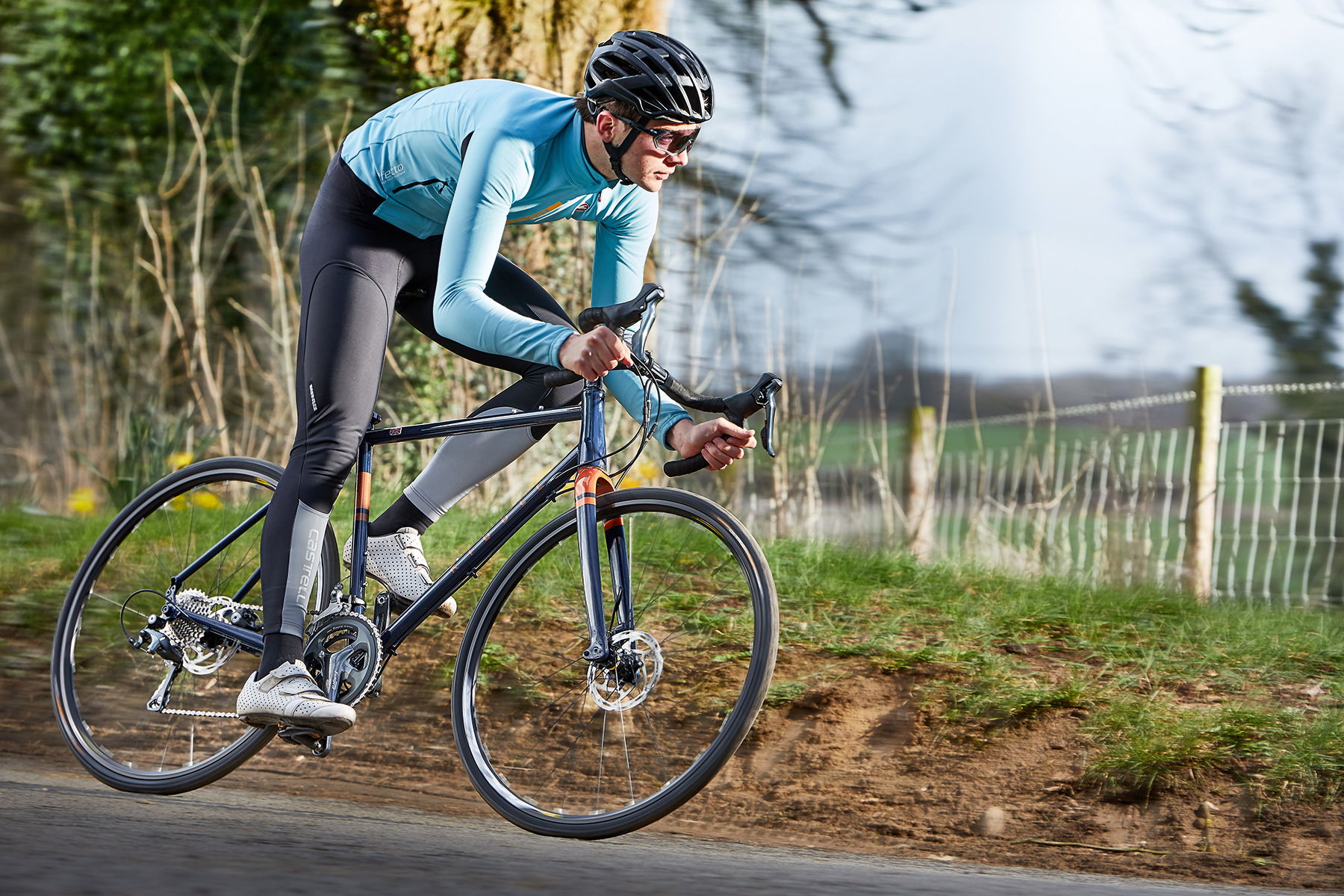
- £1,199 / $1,257 / AU$1,965 as tested
- Pros: Immensely versatile; classy frame
- Cons: Touch on the heavy side
The CGR 725 Steel gets its name from the slender Reynolds 725 steel tubes it’s constructed with. The frame offers not only a classy look but a cossetting ride that is more about comfort than smashing personal bests.
You can fit 29rt, 700c or 650b wheels, making this a chassis you can really tailor to your preferences. Rear rack mounts, clearance for up to 47mm tyres and bosses at the top tube add further versatility. The CGR could happily clock commuting, fitness, adventure or even training miles.
At a smidge over 11kg, it’s a little weighty though, and the TRP mechanical discs are good rather than great.
Surly Grappler

- £2,350 / £1,949 as tested
- Pros: Smooth and stable on tricky terrain; high-quality frame
- Cons: Lesser brakes; drivetrain arguably not up to Shimano or SRAM quality
The Surly Grappler is noticeably taller than many of the best gravel bikes and also has a long reach. While our tester was sceptical of this geometry at first, they found it to create a brilliant bike that’s planted, solid and ideal for exploring.
The 27.5×2.5in Teravail Ehline tyres swallow up rocks and roots, while the dropper post turns it into a wicked descender.
In typical Surly style, the frame is high quality and has plenty of mounts, so you can make the most of the Grappler’s long-distance potential.
Arguably, the Microshift drivetrain and weak Tektro brakes aren’t up to the quality or performance of a Shimano or SRAM groupset.
What is a gravel bike?
A gravel bike is a drop-bar bike designed to be ridden on a wide variety of surfaces and not just gravel – even if this is where gravel riding did originate.
The best gravel bikes look a lot like traditional road bikes, but there are four key features that usually distinguish them.
Wider tyres

First and foremost, gravel bikes have wider tyres. Since these bicycles are designed to traverse miles of unpaved roads, their tyres are substantially larger. Likewise, mud clearance is also a concern in these conditions.
Tyre widths range anywhere from 30mm to 48mm. In addition to 700c wheels, it is also common to see smaller-diameter 650b wheels used with higher-volume tyres. Many of the best gravel bike tyres feature a fast-rolling centre tread with knurling or side knobs to improve cornering ability on mixed surfaces.
Tubeless tyres are also commonly found on gravel bikes because the latex tubeless sealant provides a degree of insurance against punctures.
Geometry
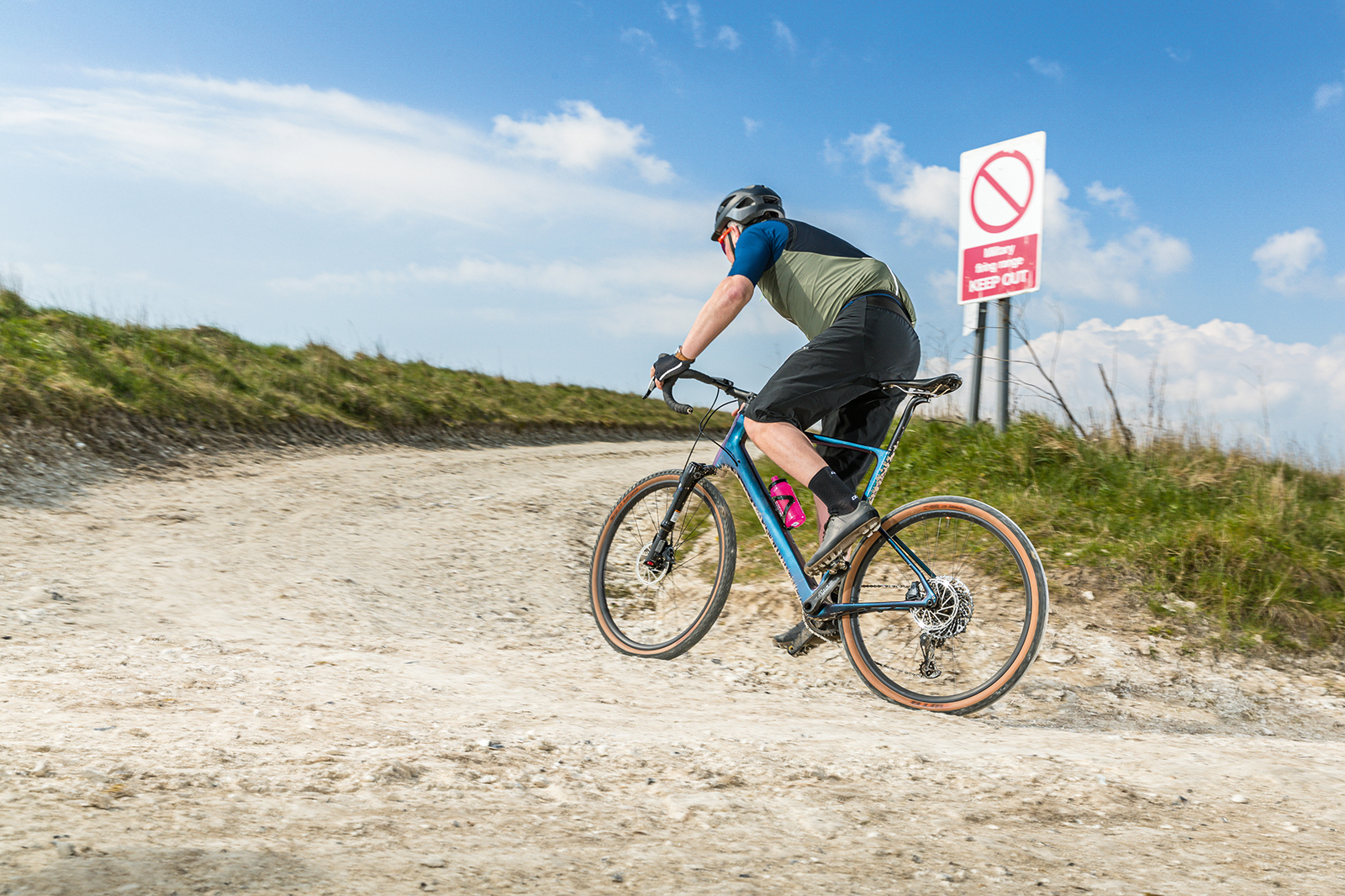
In addition to wider tyres, gravel bikes have geometry that favours stability and comfort.
The best gravel bikes have a longer wheelbase than most road bikes thanks to longer chainstays and slacker head-tube angles.
Head tubes are generally taller as well, placing the rider in a more relaxed, upright position. Bottom brackets are often lower, which gives the rider the sensation of riding in, rather than on the bicycle.
The end result of these geometry differences is a more comfortable, confidence-inspiring and forgiving ride than you would find in a typical road bike.
The best women’s gravel bikes follow the same principles in terms of geometry but are often tailored to better suit women riders.
Frame features
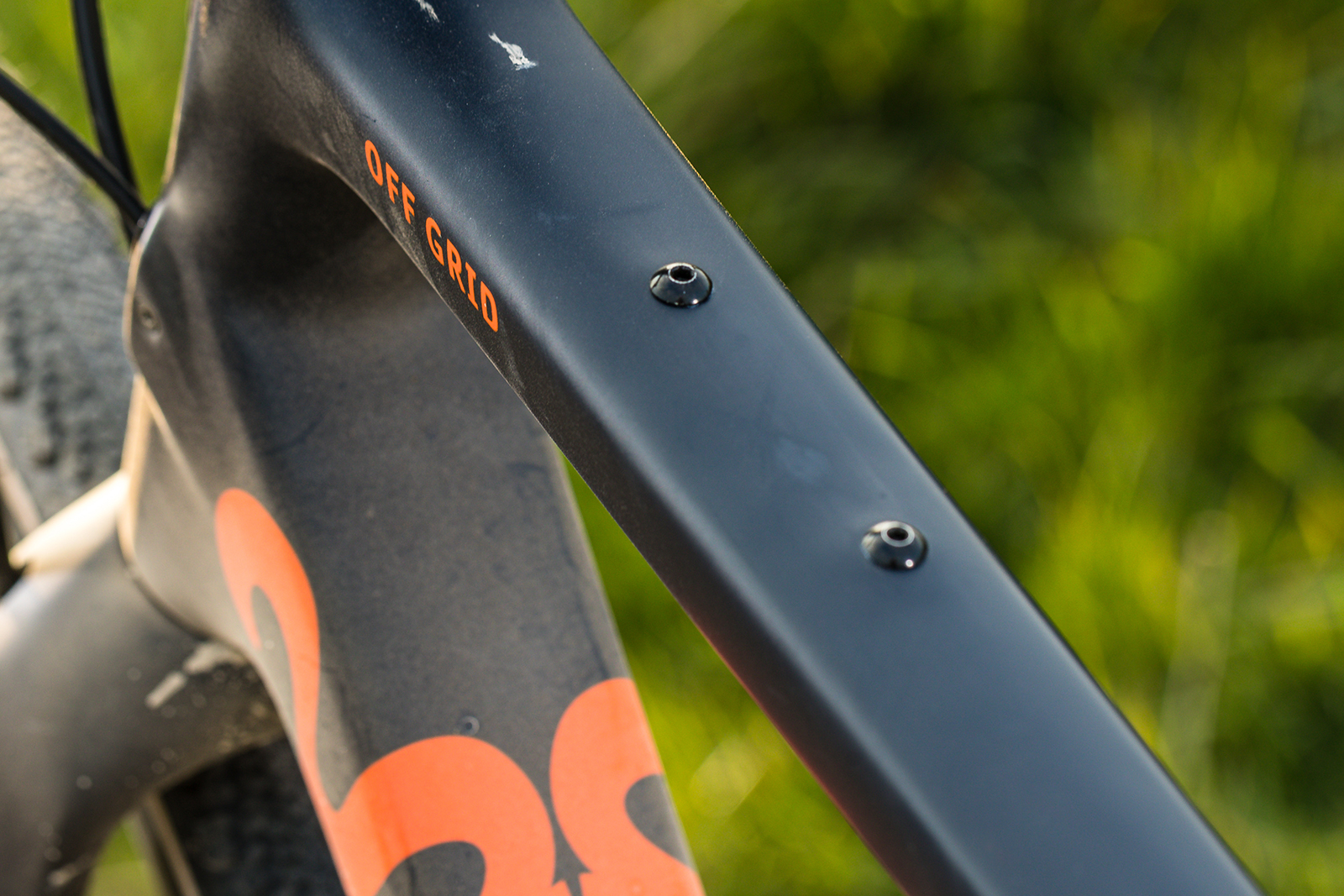
Another thing you’ll usually find on gravel bikes that road bikes don’t have is extra mounting points for luggage. That allows them to be used for bikepacking or just lets you add a third water bottle for long rides in the outback where water sources may be scarce. Likewise, there are often mounts on the top tube for a feed bag.
Gravel bikes also usually have mounts for a rack and mudguards/fenders, so they can do double duty as poor weather road bikes.
There’s a newer category of gravel race bikes though, like the Pinarello Grevil F and the Cervélo Áspero, which abandon their bikepacking pretensions and just have a fairly standard set of road-type mounts, maybe with extra bottle cage bosses under the down tube. They’ll have a more racy geometry, more like a road bike, and often include aero features and tube profiles.
Handlebars and stem
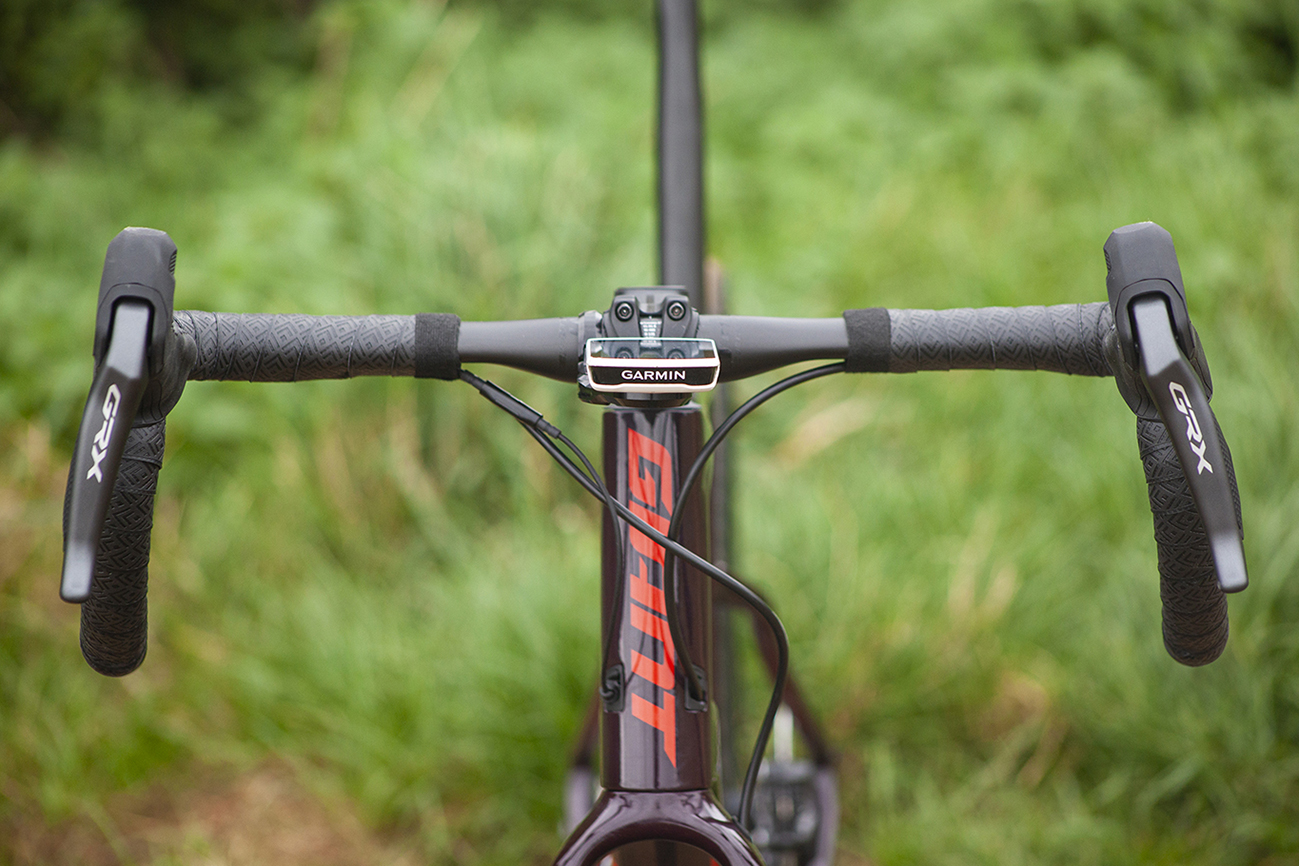
Gravel bikes typically have a shorter stem and wider handlebars than road-going drop bar bikes. That mirrors mountain bike geometry and leads to a bike that’s more easily manoeuvred over variable terrain.
The handlebars usually have a flare to them, where they widen out from the tops to the drops. That gives you more control when descending in the drops. It also means that if you decide to fit a handlebar bag, there’s more space to grab the drops without the bag getting in the way.
Gearing

Gearing is another area where gravel bikes diverge from the pack.
The rise of gravel bikes has, in turn, been accompanied by the arrival of gravel-specific groupsets. While early gravel bikes might have featured road bike groupsets with compact cranksets, the latest gravel groupsets – including Shimano GRX, Campagnolo Ekar and SRAM XPLR – provide a more suitable and forgiving selection of gears.
Given the terrain, many gravel bikes feature sub-compact cranksets and wide-range cassettes, to give a spread of gearing that remains fast on the road, while providing a low enough bottom gear for off-road climbing.
Double cranksets with 48/32t chainrings are common. Likewise, many gravel bikes come with 1x gearing and super-wide cassettes, keeping the drivetrain simple by removing the front derailleur.
You can read our guide to gravel bike setup for more on gearing choices.
Suspension

In addition to wide tyres, relaxed geometry and low gearing, many of the latest machines have active or passive gravel bike suspension systems built into them.
Much like bikes in the endurance road category, these features could take the form of slender chainstays, a bowed top tube or a skinny seatpost, all of which are designed to flex in order to absorb road chatter.
Some of the best gravel bikes take things one step further by using short-travel suspension forks, such as the Lefty Oliver or aesthetically odd but very effective Lauf Grit fork.
We’ve also seen the arrival of the RockShox Rudy XPLR gravel fork and the Fox 32 Taper-Cast Gravel.
How much do I have to spend on a gravel bike?
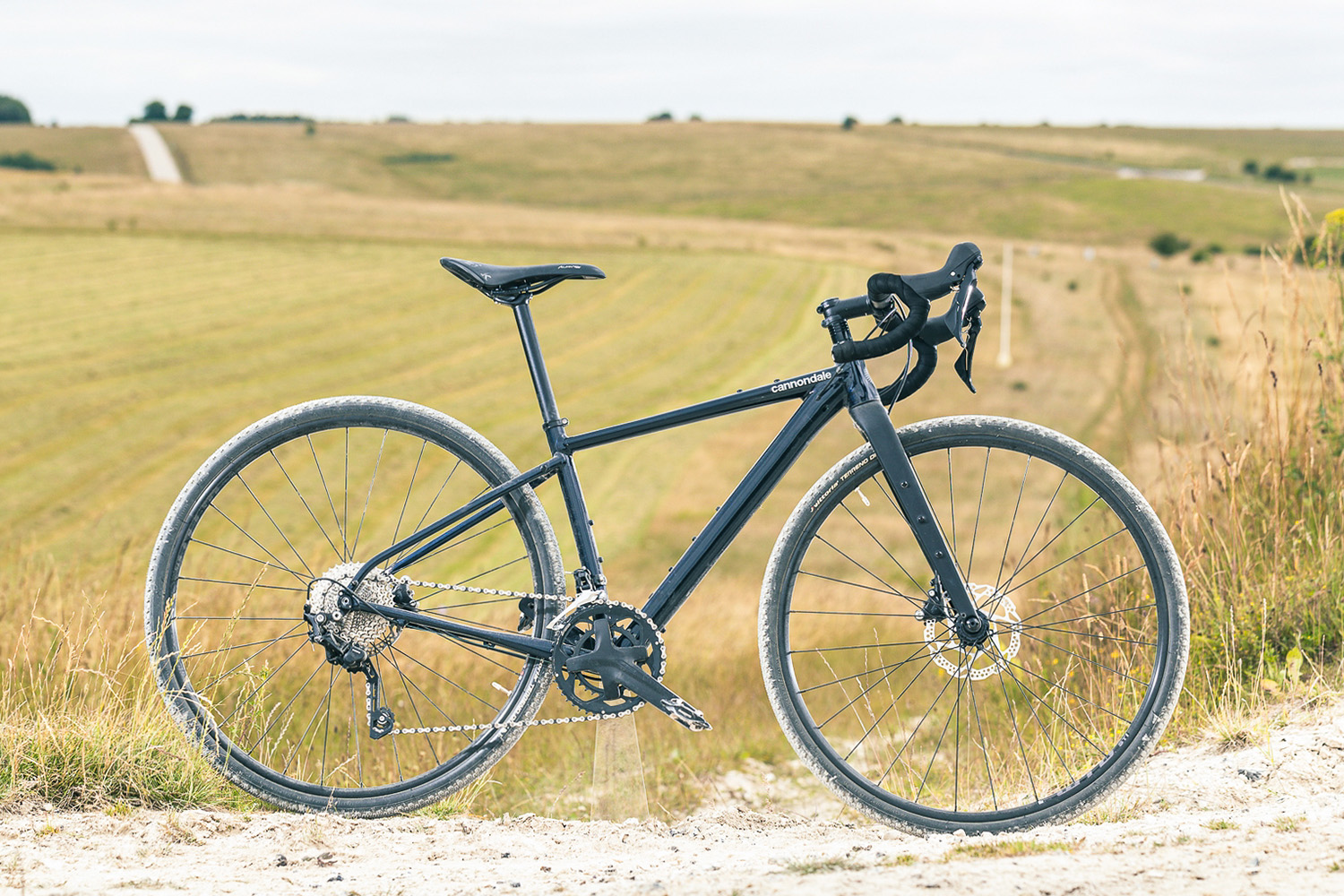
Well, that depends on what you define as a gravel bike. A used cyclocross bike, for example, could work perfectly well as a gravel bike and cost you a fraction of the cost of even the most basic ‘true’ gravel machine.
You can buy gravel bikes for under £1,000 with an alloy frame with entry-level components with gravel bikes under £2,000 offering slightly higher specs.
A mid-range build from a major brand will likely cost in excess of £2,000 / $2,800. Aluminium frames still dominate here but they’ll sport more up-to-date designs in terms of tubing, geometry, tyre clearance and mounting points.
Spend more and you’ll start to step into the world of carbon frames, with upscale components to match.
As is normally the case in the cycling world, it’s possible to spend a small (or not so small) fortune on a custom-built bike should you wish to.
What else do I need for gravel riding?
The growth in gravel riding has been matched with the growth in gravel-specific kit. While you can go gravel riding with your normal cycling – or sports – kit, there are numerous gravel accessories, pedals and shoes that can enhance your time riding off-road.